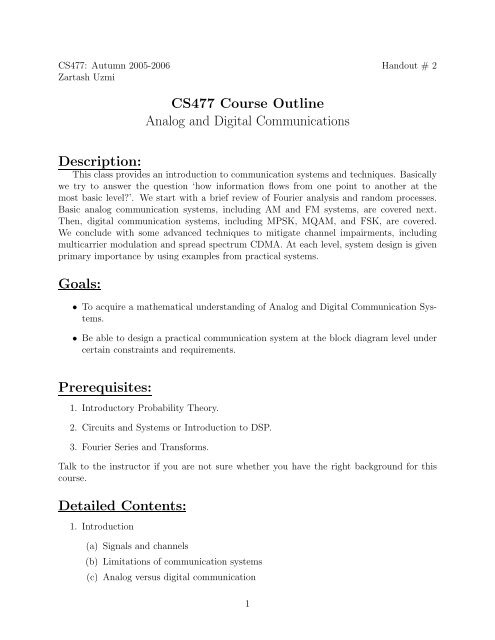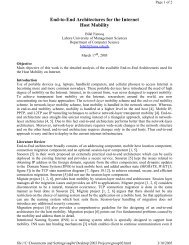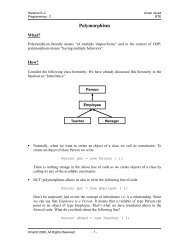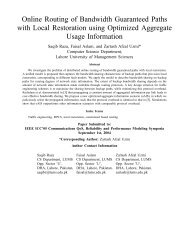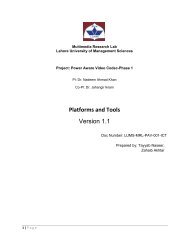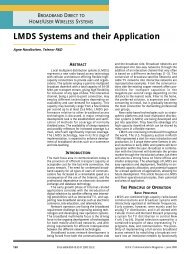CS477 Course Outline Analog and Digital ... - Suraj @ LUMS
CS477 Course Outline Analog and Digital ... - Suraj @ LUMS
CS477 Course Outline Analog and Digital ... - Suraj @ LUMS
Create successful ePaper yourself
Turn your PDF publications into a flip-book with our unique Google optimized e-Paper software.
<strong>CS477</strong>: Autumn 2005-2006 H<strong>and</strong>out # 2<br />
Zartash Uzmi<br />
<strong>CS477</strong> <strong>Course</strong> <strong>Outline</strong><br />
<strong>Analog</strong> <strong>and</strong> <strong>Digital</strong> Communications<br />
Description:<br />
This class provides an introduction to communication systems <strong>and</strong> techniques. Basically<br />
we try to answer the question ‘how information flows from one point to another at the<br />
most basic level?’. We start with a brief review of Fourier analysis <strong>and</strong> r<strong>and</strong>om processes.<br />
Basic analog communication systems, including AM <strong>and</strong> FM systems, are covered next.<br />
Then, digital communication systems, including MPSK, MQAM, <strong>and</strong> FSK, are covered.<br />
We conclude with some advanced techniques to mitigate channel impairments, including<br />
multicarrier modulation <strong>and</strong> spread spectrum CDMA. At each level, system design is given<br />
primary importance by using examples from practical systems.<br />
Goals:<br />
To acquire a mathematical underst<strong>and</strong>ing of <strong>Analog</strong> <strong>and</strong> <strong>Digital</strong> Communication Systems.<br />
Be able to design a practical communication system at the block diagram level under<br />
certain constraints <strong>and</strong> requirements.<br />
Prerequisites:<br />
1. Introductory Probability Theory.<br />
2. Circuits <strong>and</strong> Systems or Introduction to DSP.<br />
3. Fourier Series <strong>and</strong> Transforms.<br />
Talk to the instructor if you are not sure whether you have the right background for this<br />
course.<br />
Detailed Contents:<br />
1. Introduction<br />
(a) Signals <strong>and</strong> channels<br />
(b) Limitations of communication systems<br />
(c) <strong>Analog</strong> versus digital communication<br />
1
2. Representation of Signals<br />
(a) Fourier series <strong>and</strong> spectra<br />
(b) Fourier Transforms <strong>and</strong> its type<br />
3. Transmission <strong>and</strong> filtering<br />
4. Correlation <strong>and</strong> power spectral density<br />
5. Linear Continuous wave modulation<br />
(a) DSB+C <strong>and</strong> DSB-SC<br />
(b) SSB <strong>and</strong> VSB<br />
(c) Example Communication System (TV/Radio)<br />
6. Exponential Continuous wave modulation<br />
(a) Frequency Modulation<br />
(b) Phase Modulation<br />
7. R<strong>and</strong>om signals <strong>and</strong> Noise<br />
(a) Noise in baseb<strong>and</strong><br />
8. Passb<strong>and</strong> Noise<br />
(a) Noise in linear CW systems<br />
(b) Noise in exponential CW modulation<br />
9. Sampling <strong>and</strong> Baseb<strong>and</strong> digital transmission<br />
(a) <strong>Digital</strong> PAM, PCM, <strong>and</strong> Delta modulation<br />
(b) Matched filtering<br />
10. B<strong>and</strong>pass digital transmission<br />
(a) <strong>Digital</strong> CW modulation<br />
(b) Coherent <strong>and</strong> non-coherent binary systems<br />
(c) QAM <strong>and</strong> QPSK<br />
11. Spread Spectrum modulation<br />
12. Multicarrier Modulation<br />
13. Error detection <strong>and</strong> correction<br />
2


